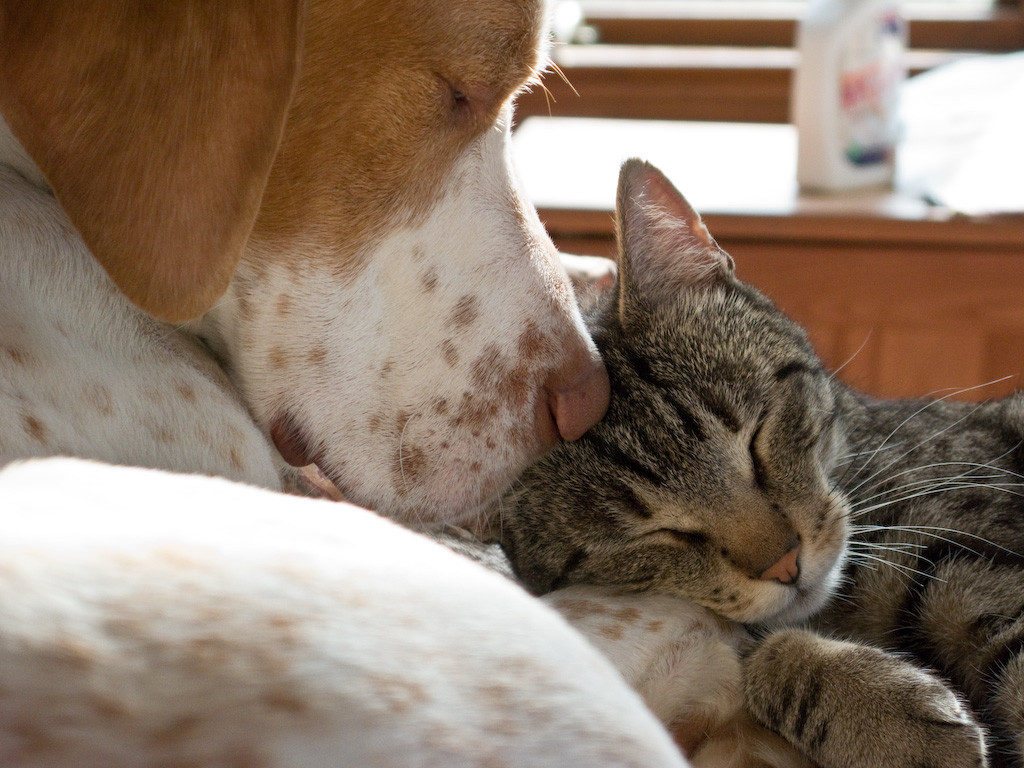For ages, a playful rivalry has persisted among pet lovers: who reigns supreme in the intelligence department – dogs or cats? Dogs are celebrated for their trainability and eager responses to commands, often seen as hallmarks of smarts. Cats, on the other hand, with their enigmatic independence and hunting prowess, present a different kind of cleverness. This enduring question of feline versus canine intellect has finally been approached through the lens of modern science.
To delve into this age-old debate, PBS NewsHour consulted with leading experts: a neuroscientist specializing in brain structure, a dog cognition expert, and a researcher focused on cat behavior and cognition. Intriguingly, when one of these scientists undertook the task of counting brain cells, a surprising leader emerged. However, contemporary research into animal behavior and intelligence compels us to reconsider traditional notions of what truly defines “smart.”
The Neuron Count: Dogs Edge Out Cats in Brain Cell Census
Neuroscientist Dr. Suzana Herculano-Houzel, driven by a quest to understand animal intelligence, has pioneered a unique approach: directly counting neurons in animal brains. Her method involves liquefying brain tissue to accurately quantify these fundamental units of intelligence. Her groundbreaking findings reveal a significant difference: dogs possess approximately twice the number of neurons compared to cats.
Neurons are the workhorses of the central nervous system, responsible for processing and transmitting information. Dr. Herculano-Houzel’s team meticulously counted neurons specifically within the cerebral cortex – the brain’s outer, wrinkled layer associated with higher-level cognitive functions. Their study encompassed the brains of eight carnivorous mammal species, including cats and dogs alongside ferrets, mongooses, raccoons, hyenas, lions, and brown bears. The comprehensive research was published in the prestigious journal Frontiers in Neuroanatomy in late 2017.
The brains examined in this study were ethically sourced from animals that had already passed away, generously donated by zoos, wildlife rehabilitation centers, forest preserves, and compassionate pet owners.
 Herculano-Houzel disclosed that she kept her biases out of the research, but said her dog, Mielina, is a great example of why dogs are smarter than cats. Photo by Suzana Herculano-Houzel
Herculano-Houzel disclosed that she kept her biases out of the research, but said her dog, Mielina, is a great example of why dogs are smarter than cats. Photo by Suzana Herculano-Houzel
Scientist Suzana Herculano-Houzel with her dog Mielina, humorously suggesting dogs’ superior intelligence based on her research.
The innovative technique employed, developed by Dr. Herculano-Houzel, was initially created to determine the neuron count in the human brain. This method involves transforming the brain into a liquid state, effectively dissolving each individual neuron. By reducing the brain matter to a soup-like consistency, only the nuclei of neurons remain suspended, allowing researchers to accurately count them.
Applying this method, the team discovered that dogs boast around 530 million neurons in their cerebral cortex, whereas cats have approximately 250 million. To put this in perspective, the human cerebral cortex contains a staggering 16 billion neurons. Dr. Herculano-Houzel suggests that even smaller dog breeds, such as Chihuahuas or Corgis, likely possess more neurons than their feline counterparts.
“The logical implication,” Dr. Herculano-Houzel stated, “is that, yes, dogs are demonstrably more capable than cats in terms of neural processing power based on neuron count.”
Unexpected Brainpower: Raccoons Defy Size Stereotypes
Beyond the dog-cat comparison, the study yielded surprising insights among other animal species. Counter to the long-held belief that brain size directly correlates with intelligence, the research revealed that larger animals like hyenas, lions, and brown bears actually possessed fewer neurons than some smaller creatures. Neuroscience had previously leaned towards the idea that “bigger brain equals bigger brainpower.” However, Dr. Herculano-Houzel’s findings showed that bears have a comparable number of cortical neurons to cats, despite their significant size difference.
Another unexpected revelation came from raccoons, renowned for their clever and adaptable nature. While a raccoon’s brain is roughly the size of a cat’s, it contains a neuron count comparable to that of a dog. The ratio of brain size to neuron density in raccoons even resembles that observed in some primates, highlighting their efficient brain organization.
“The remarkably high neuron count we observed in raccoon cortices aligns perfectly with their reputation for ingenuity,” Dr. Herculano-Houzel explained. “It supports anecdotal evidence of these creatures’ problem-solving abilities, particularly when it comes to securing food.”
Dr. Herculano-Houzel’s team also examined neuron counts in herbivores, using data collected by other research groups. Their initial hypothesis was that grazing animals, requiring less energy for hunting and complex foraging, might have fewer neurons. However, they discovered that herbivores packed just as many neurons as their carnivorous counterparts. This pattern held true when comparing domesticated animals to their wild relatives.
These findings collectively suggest that brain size alone is not a reliable indicator of intelligence. Evolution and selective breeding have not solely favored species or body sizes based on neuron count. Intelligence, it seems, comes in various sized packages, as Dr. Herculano-Houzel concluded.
The Spectrum of Intelligence: Moving Beyond a Simple Ranking
Dr. Brian Hare, the founder and director of Duke University’s Canine Cognition Center, advocates for a nuanced perspective when discussing intelligence across species. He cautions against simplistic rankings, arguing that the very concept of intelligence is often viewed through a human-centric lens.
“Asking which species is smarter is akin to asking if a hammer is a superior tool to a screwdriver,” Dr. Hare, who was not involved in Dr. Herculano-Houzel’s study, explained. “Each tool is designed for a specific task, so its ‘superiority’ depends entirely on the problem at hand.”
Evolution has shaped each species to excel at solving the challenges most critical to its survival and reproduction within its specific environment. The image of a dolphin perched in a tree appears as absurd as a chimpanzee attempting to fish in the ocean. Yet, research demonstrates that both dolphins and chimpanzees exhibit remarkable intelligence within their natural habitats and when tackling species-relevant tasks.
So, how should scientists approach the study of animal cognition without imposing a hierarchical view of intelligence?
“Much of what we understand about intelligence in different species exists on a gradient or a spectrum, rather than a linear scale,” explains Dr. Kristyn Vitale Shreve, a leading cat cognition and behavior research fellow at Oregon State University.
Consider hunting prowess, for instance. Cats occupy the highly skilled end of the spectrum, while dogs fall in the middle, and humans reside closer to the lower end. However, if we were to assess mathematical abilities, humans would shift towards the more intelligent end, while dogs and cats would move further away.
In essence, directly comparing different species in a quest to declare one “smarter” than another is inherently flawed because they exhibit intelligence in diverse ways, tailored to their ecological niches and evolutionary pressures. However, Dr. Vitale Shreve emphasizes the importance of comparative studies to understand how broad behavioral patterns relate to brain physiology – especially in light of new insights into neuron quantities across species.
 Regardless of how many neurons dogs and cats have, they
Regardless of how many neurons dogs and cats have, they
Dogs and cats, regardless of neuron counts, are intelligent companions deserving of affection and care.
Both Dr. Vitale Shreve and Dr. Herculano-Houzel acknowledge the challenges of studying intelligence through behavioral experiments, which often involve animals performing tasks or solving puzzles designed by humans. Furthermore, direct comparative studies between dog and cat cognition are scarce. In fact, research focusing specifically on feline cognition remains relatively limited. Dr. Vitale Shreve argues that until scientists develop more refined and species-appropriate methodologies for investigating both dogs and cats, direct intelligence comparisons remain inherently unfair and potentially misleading.
“There’s a persistent perception of cats as being untrainable or less cooperative research subjects,” Dr. Vitale Shreve notes. “Cats exhibit a wide range of individual personalities and behavioral variations, which can make them more challenging for researchers to study and understand using standardized methods.”
Ultimately, intelligence is a multifaceted and complex phenomenon. However, Dr. Herculano-Houzel offers a unifying message for all pet owners:
“Please cherish your cats and dogs equally, with all the love you have to give,” she encourages. “Regardless of their neuron counts, the bond we share with our companion animals transcends any numerical comparison of intelligence.”
